
Black mold, also called Stachybotrys chartarum, is one of these types of toxic molds. Black mold can cause health problems for home occupants and can even cause damage to buildings, walls, carpeting, furniture, and more. If you discover black mold in your home, the absolute worst thing to do is ignore it. Over time, there can be long-term effects of black mold on children and pets.
How does mold affect children and pets? And how can you safely remove black mold? Let’s review the impacts of mold on kids and our furry family members and walk through the steps to remove mold.
Black Mold and Children
Children, especially infants, can be impacted by black mold exposure. When they inhale black mold spores or come into skin or eye contact with it, they can develop health issues including respiratory illnesses. The symptoms of mold exposure in children include:
- Itchy, watery eyes
- Sneezing
- Wheezing or trouble breathing
- Coughing
- Headache
- Nosebleed
- Joint pain, muscle aches
- Fatigue or weakness
- Skin irritation
If your child exhibits any of the symptoms of black mold exposure, have them examined by their pediatrician. The physician may prescribe breathing treatments or other remedies to help your child recover quickly. In some extreme cases, black mold exposure can lead to serious medical conditions including asthma, bronchitis, and other lung infections.
Toxic black mold should be remediated as soon as possible to improve the air quality for your family. Mold problems do not go away on their own. For some mold issues, you may be able to remove the mold yourself. In other cases, it makes sense for a professional mold and mildew remediation company to handle the mold growth issue for you.
Black Mold and Pets
Just like humans, black mold can affect the health of pets. Pets tend to have a higher exposure rate to mold since they are more likely to explore areas of a home with mold (think basements, attics, etc.). Many of the symptoms humans have after a mold exposure are shared by pets and include:
- Allergy symptoms such as sneezing and watery eyes
- Nose bleeds
- Fatigue
- Loss of appetite
Symptoms specific to pets include:
- Excessive scratching without the presence of fleas (mold can cause skin irritations in pets)
- Excessive licking or fur/hair loss
- Chewing or nipping at their skin
In some rare, extreme cases, when a pet is exposed to mold, it can cause a pulmonary hemorrhage. If you suspect your pet is suffering from a mold exposure, take them to your veterinarian as soon as possible for treatment.
Learn About Our Mold Remediation Restoration Services
How to Remove Mold
If you’ve found mold in your home, especially black mold, you’ll want to remove it quickly and most importantly, safely. If mold isn’t removed properly, it can actually spread and become worse. Before you begin any mold removal, gather the proper safety equipment including gloves, masks, and goggles to protect your respiratory system. Other safety precautions include throwing out any contaminated items and opening windows and doors.
If your mold infestation is larger than 10 square feet, reach out to Reynolds Restoration Services for help with mold removal and mitigation. For small mold issues, here are steps to safely remove mold:
- Find – and fix – the cause of mold: Mold needs three things to thrive – moisture, a food source, and oxygen. Many mold issues begin when there is a leaky pipe, roof leak, AC malfunction, or other water damage issue. Once you’ve fixed the problem, dry out the affected area with dehumidifiers and fans.
- Remove mold from surfaces: There are many different types of products you can use to remove mold. The most common ways to remove mold are bleach, hydrogen peroxide, white vinegar, baking soda, and borax. Important! Never mix bleach with other chemicals.
Even skilled DIYers should take caution when removing mold on their own. Mold growth can get worse and spread throughout a home quickly through the ventilation system. Remember, mold is airborne and can travel quickly once disturbed at its source.
Reynolds Restoration Services Mold Remediation
Long-term exposure to black mold for children and pets can cause health issues. If you’ve discovered it in your home, reach out to Reynolds Restoration Services for mold remediation as soon as possible. While you may be tempted to remove the mold yourself, our team has the proper training, tools, and resources to attack the issue quickly and remove toxic black mold safely.
We have been serving homeowners for more than 15 years in the emergency restoration services field. Our team of trained emergency mitigation specialists can respond to water and flood issues, storm damage, fire damage, and mold problems. We are on-call 24/7 and with offices in Harrisburg, Pa., Philadelphia, Pa., and the Baltimore/DC region, we can be on-site quickly to help. While we hope you never need us, we are here to respond and rebuild with care.

President of Reynolds Restoration Services. Over 20 years of experience in the emergency restoration industry.

